The Web of Institutional Control in Southwest Missouri
Part 1 of 3: Do you know who is controlling you? Who is the menacing Spider in the dark? It's backed by $427M to wrap you up and leave you a victim of the government.
Preface:
Legal Notice and Disclaimer
The views and opinions expressed in these articles are those of the author and do not necessarily reflect the official policy or position of any organization mentioned herein. All assertions made are based on publicly available information, documents obtained through legal channels, and statements from involved parties.
This work is presented as investigative journalism and analysis. While every effort has been made to ensure accuracy, readers should independently verify any facts or claims important to their decisions. The articles contain both factual reporting and analysis/opinion, which are clearly distinguished throughout the text.
Any reference to wrongdoing should be understood as alleged unless proven in a court of law. Organizations and individuals mentioned have the right to respond, and this work welcomes corrections of factual errors with appropriate documentation.
This three-part investigative series documents and analyzes the network of institutional relationships operating in Southwest Missouri, centered around Springfield and Christian County. Through examination of public records, financial documents, and organizational connections, these articles map how various institutions interact to influence public opinion and policy. The focus is on understanding systemic patterns rather than alleging individual or organizational misconduct.
The investigation began with questions about the Springfield Daily Citizen's coverage of local issues but expanded to uncover a sophisticated system of influence involving:
The Community Foundation of the Ozarks ($427M in assets)
Missouri State University
The Chamber of Commerce
Various nonprofit organizations, including U-Turn in Education
Local media outlets
Religious institutions
Key findings include:
Hidden donor structures and complex financial relationships
Coordinated messaging across supposedly independent organizations
Use of charitable giving as a mechanism of control
Strategic deployment of media coverage
Institutional pressure on community decision-making
This work represents over a year of investigation into how modern institutional control operates through seemingly benevolent organizations rather than direct government action. While Southwest Missouri is highlighted, the patterns revealed here may be instructive for understanding similar dynamics in other communities, the state, and the nation.
The articles are presented chronologically as the investigation expands, with each piece building on previous findings to construct a comprehensive picture of institutional influence in the region. Readers are encouraged to pay particular attention to the documented connections between organizations and the flow of money through various charitable structures.
This investigation raises fundamental questions about transparency, accountability, and the nature of institutional power in local communities. While the findings are specific to Southwest Missouri, they suggest patterns that may be worth examining in other regions where similar institutional networks exist.
Note on Sources and Methods: Information in these articles comes from public records, official documents, direct statements, and other verifiable sources. Where analysis or interpretation is offered, it is clearly identified as such. The authors maintain documentation for all factual claims and welcome good-faith corrections with supporting evidence.
Copyright Notice: This work is protected by applicable copyright laws. No part may be reproduced without permission, except for brief quotations in critical reviews and certain other noncommercial uses permitted by copyright law.
The Institutional Mafia’s PR Firm
The Springfield Daily Citizen was formed to combat Misinformation and Divisive Discourse—but its news is a product of woke ideology and radical progressive tropes.
Citing misinformation in August 2021, along with claims of concerns about declining local news coverage, the Springfield Daily Citizen emerged with ambitious promises.
“The 2021 Focus Report cited concerns about the decline of locally owned media in our community and the negative impact of misinformation and divisive discourse. Unlike the traditional for-profit press, which cuts staff, coverage, and publication schedules, we can report the stories our community wants to read without artificial budget constraints driven by corporate interests.”
The Springfield Daily Citizen’s mission statement declared it would "inform our community and be a catalyst for good." The organization was an independent, nonprofit news source dedicated to unbiased community coverage.
But a deeper investigation reveals a complex web of institutional control, hidden donors, and coordinated influence that raises serious questions about its independence and transparency."
The Springfield Daily Citizen’s mission statement declared it would "inform our community and be a catalyst for good." The organization was an independent, nonprofit news source dedicated to unbiased community coverage.
But a deeper investigation reveals a complex web of institutional control, hidden donors, and coordinated influence that raises serious questions about its independence and transparency.
The Foundation
Incorporated as a 501(c)(3) in August 2021
Immediately housed at Missouri State
University's Freudenberger House
Partnership with KSMU Public Radio
Claims $1 million annual operating budget



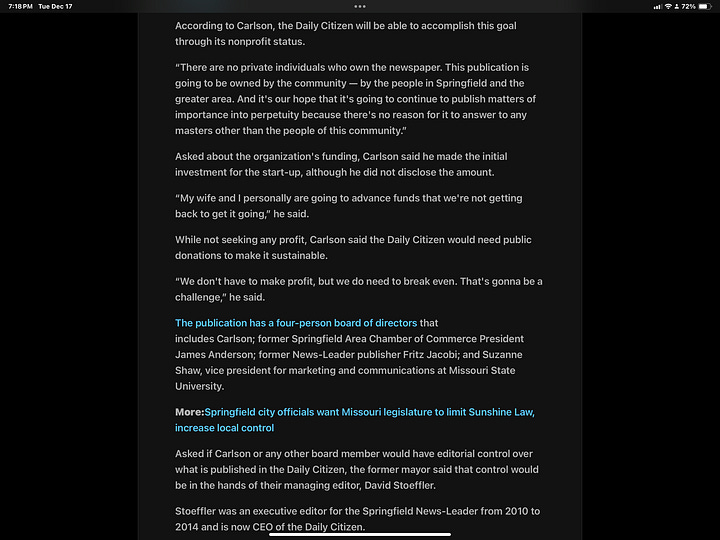




The Hidden Donors
An examination of their 2022 and 2023 990 tax forms reveals a troubling lack of transparency:
- In 2022, 41 separate donors are making significant contributions
- Individual donations as large as $250,000
- All donor identities are listed as "N/A” because they hide the amounts given by whom. For an organization that wants to be transparent enough for you to trust them, they are acting like a corporation hiding their business interests rather than a non-profit being upfront about “misinformation and divisive discourse.”




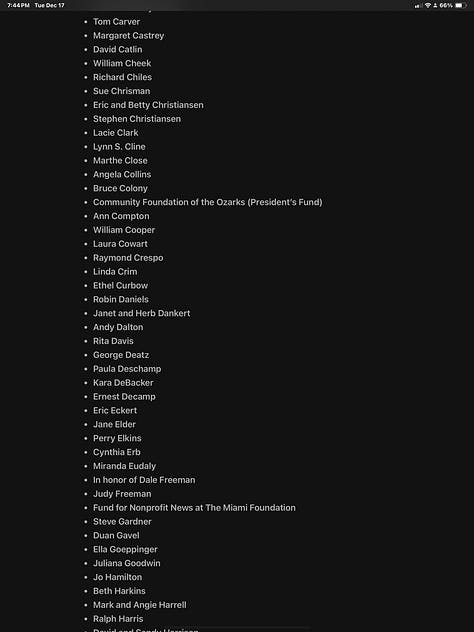



- Total contributions of $979,180
- No public disclosure of who controls the purse strings
Their 2023 Filing is listed on Propublica, a website that tracks politics but also non-profits. Springfield Daily Citizen currently does not list this on their website.
Possible Collusion
As a side note, they borrow part of their statement, “Our news judgments are made independently–not based on or influenced by donors or any revenue source. We do not give supporters the rights to assign, review or edit content” from several other non-profit news sources. This shows how deep this web of influence goes.
Remember this video of the news anchors all repeating the same story over and over again, showing collusion in reporting?
Multiple local news stations say the same thing verbatim
Returning to Propublica
Returning to ProPublica, the donor data is shown as restricted. As a grant writer, I can’t remember ever seeing an organization going out of its way to hide its donors. I looked at thousands to find donors and funders to connect them. This is strange, but maybe not unheard of, as I only did it for a year. I did grant writing for another non-profit news organization, helping them find funders, and it was vital for them to show their Board members, their current donors, and how much they had received so they could attract new nonprofit donations.
This other nonprofit news organization could not hide its donors if they wanted to be successful. It was essential to show their donors. In the grant writing world, proving who has donated to you buys you credibility. If other credible individuals believe in you and have given you large amounts, which can be demonstrated on tax records, you share that information. Hiding it goes against everything I learned. That said, Springfield Daily Citizen lists their donors as Restricted and the Total Contributions as Restricted.
While they will list their donor's names and break it up by $5000 amounts, this nebulous line, when the amounts go up to $250,000, leaves a lot of room for serious questions.
Do their donors get favorable coverage?
Do their donors move the needle on news coverage?
Do their donors direct them to cover certain DEI, Woke Stories as covered by the 2021 and 2023 Focus Report?
Is there an unspoken, hand-in-hand connection between these organizations to move the news, issues, and policies in the same direction because of money and power?
Is Springfield Daily Citizen a news organization or a Collective Action Public Affairs Website? (Collective Action means Marxism).
The Institutional Web
The Daily Citizen claims independence while being deeply embedded in Springfield's power structure:
Missouri State University provides facilities and services
Community Foundation of the Ozarks fiscal sponsorship
KSMU Public Radio Collaboration
Pattern of Control
Because of Susan Wade’s coverage of the Christian County Library and its board members, Gretchen Garrity and I wrote articles countering her coverage and her “facts.” Our coverage and rebuttals can be found here through these links.
Right to Win Ozarks “How Fake News Builds Destructive Narratives.”
Springfield Daily Citizen and KMSU
The Springfield Daily Citizen operates as part of a sophisticated institutional control system, with a claimed $1 million annual operating budget while being housed at Missouri State University's Freudenberger House.
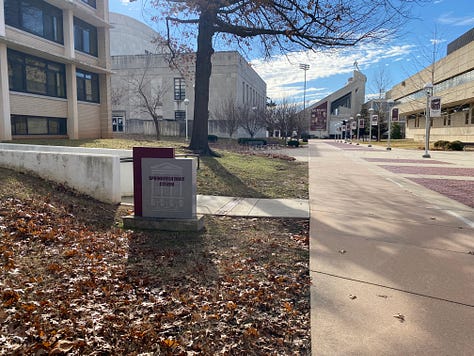
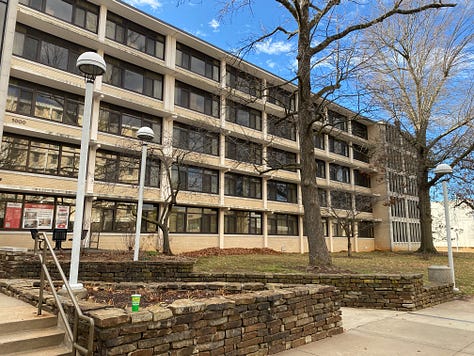
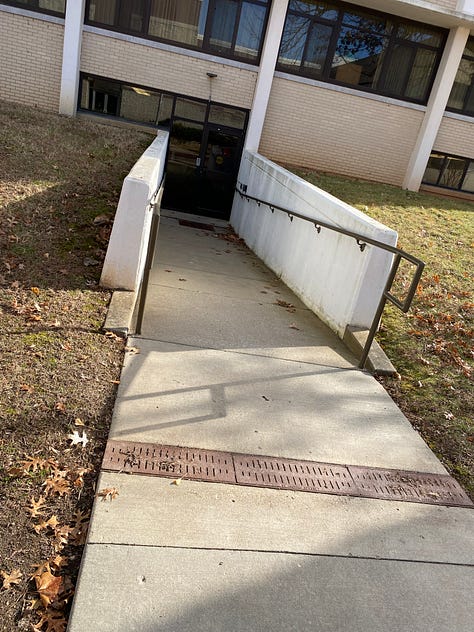

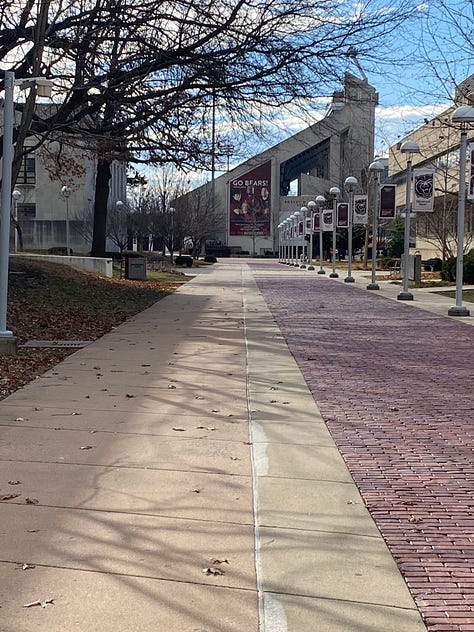
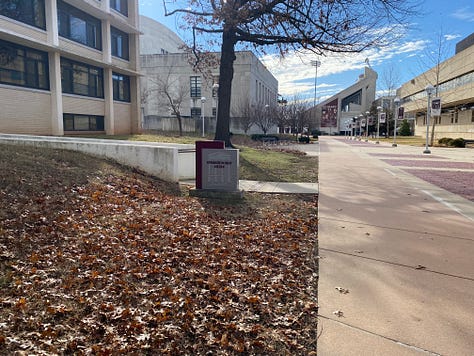
The organization's structure raises significant transparency concerns, particularly regarding its donor base, which includes 41 separate donors making contributions as substantial as $250,000, all listed as "N/A" in their public disclosures. Their operational model appears to rely heavily on hidden subsidies and institutional support that masks their actual costs, as their reported budget seems insufficient to cover their extensive marketing presence and operational expenses.
The publication demonstrates a pattern of institutional protectionism through its coverage choices and response to criticism. When faced with documented criticism of its reporting practices, the Springfield Daily Citizen has shown a pattern of archiving controversial articles, ceasing coverage of particular topics, and responding with legal threats rather than addressing factual concerns. This behavior is exemplified in their handling of Susan Wade's report on Christian County, where articles were quickly archived after criticism, and Wade ultimately stopped covering the region. The organization's close ties to other institutional powers like the Community Foundation of the Ozarks, Missouri State University, and KSMU Public Radio suggest it functions more as an institutional public relations firm than an independent news source.
Following Susan Wade's exit from covering Christian County news and possibly any connection to Springfield Daily Citizen at all, the SDC is giving Christian County and the Christian County Library a news boycott. Further, it appears KSMU has stopped their coverage at the same time as SDC. Is there collusion between these supposedly two separate news organizations in their coverage or lack of coverage?
Susan Wade thinks a news boycott has happened since she parted ways with SDC. What does that mean? What does an independent newspaper look like that isn’t attached to its donors and revenue stream? Is it even possible?
For the record, a lack of quality news reporting is not good in any community–it’s a dark way to deal with a community that speaks of the malice of neglect.
The True Cost of "Independent" Journalism
I was curious how the Springfield Daily Citizen could operate on their claimed $1 million annual budget while reaching 35,000 subscribers—the numbers don't add up. So, I started asking some hypothetical questions about a similar type of business model using the 2022 990 form for Springfield Daily Citizen as a template.
A detailed analysis of Springfield market rates and operational requirements reveals a significant disparity between their hypothetical reported costs and what such an operation should require.
The Mute Bear
Before diving into the costs, I should explain why I'm forced to create hypothetical numbers. I filed a Sunshine Law request with Missouri State University seeking basic information about external organizations' use of university facilities - things like usage agreements, shared services arrangements, and financial records. What followed was a masterclass in institutional obstruction.
First came the delay: "University offices were closed on Friday due to the winter storm." Then, the holiday excuse: "Many of the employees we need to reach out to... are out of the office for the holiday break and will not return until the University reopens the week of January 6."
When they did respond, it was to ask for increasingly specific details about my broadly worded but legally valid request. They wanted to know if I was "specifically asking about expenses related to external media and journalism organizations for the entire University, for external organizations in Freudenberger House specifically, or something else?"
For a simple email search, they demanded exhaustive details: "Please provide us with the names of the specific former and current administrators whose emails you would like us to include in the search, as well as the names of the specific Board of Governors members."
After nearly a month of this back-and-forth, I had to explicitly spell out my interest: "I'm interested solely in Springfield Daily Citizen and no other organization." I had to clarify that I wanted information "As it pertains to Springfield Daily Citizen" and specifically about "Clif Smart and Tom Carlson about forming the Springfield Daily Citizen."
Finally, I wrote: "There has been an attempt to stymie my request through increasingly mundane minutiae and redundant and reductionistic queries... If I don't have a response detailing the records available to me in a week's time, I will file the complaint and I will publish my story explaining your unwillingness to follow state statutes."
Missouri's Sunshine Law requires governmental bodies to respond within 3 business days. They must either provide records, deny them with a specific statutory reason, or explain the delay. MSU has done none of these things effectively.
So why create hypothetical costs? Because the institution won't provide basic financial information about its relationships with external organizations. When a public university goes to such lengths to avoid sharing basic financial information about facility usage and partnerships, we're left to calculate reasonable estimates based on market rates. In the following sections, I create a model of a possible media business operating on MSU’s campus and what it might cost.
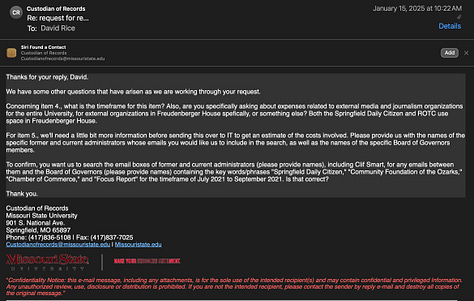
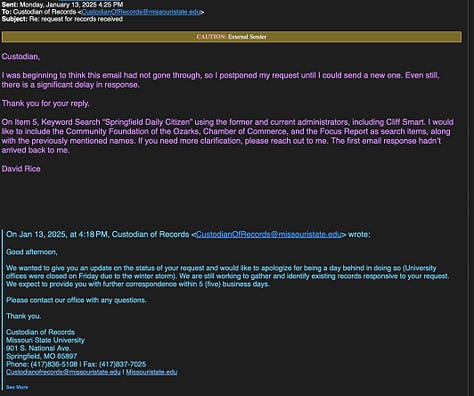
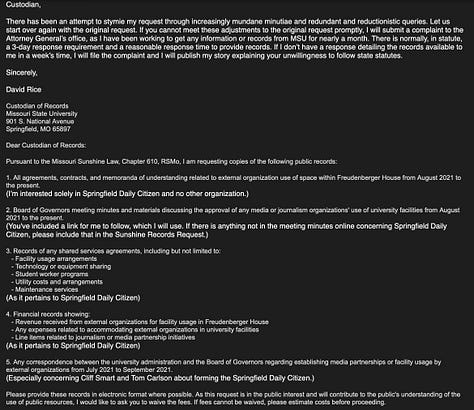
Basic Infrastructure Costs:
Commercial Office Space (5000 sq ft): $75,000-100,000
Utilities: $12,000-15,000
Insurance: $10,000-15,000
Technology/Equipment: $25,000-35,000
Professional Services: $20,000-30,000
Instead, they operate from Missouri State University's Freudenberger House, an arrangement that masks significant operational costs. This institutional support represents an unreported subsidy worth $150,000-250,000 (when you add up the total values of each group) annually in market value.
Content Creation and Staff
Full-time editorial staff (minimal): $200,000
Freelance writers ($200-500 per article):
3 articles daily = $219,000-547,500
Using students/retirees: $100-200 per article
Their reliance on freelancers, students, and retirees raises ethical questions about labor practices while obscuring actual operational costs. In a hypothetical business model similar to the Springfield Daily Citizen, you could save considerable money on writing staff by hiring students or retirees. I believe Mrs. Wade was a retired writer who returned to work for Springfield Daily Citizen.
Digital Presence
YouTube ads: $50,000-75,000
Facebook/Meta: $50,000-75,000
Other platforms: $25,000-50,000
Marketing staff/management: $60,000-80,000
Springfield Daily Citizen’s hypothetical business peer could spend a mountain of cash on advertising. I rarely watch a Facebook or YouTube video without seeing a Springfield Daily Citizen advertisement. They want to be seen. I think the numbers presented are lower than the actual costs, but I did not want to inflate the hypothetical costs and attempted to be as reasonable as possible.
An aggressive digital marketing presence would suggest spending levels that conflict with a reported $1M budget. The constant presence on platforms like YouTube and Facebook alone indicates marketing expenditures that could consume a significant portion of their claimed annual budget.
Looking at Google Ads Transparency, they have over 77 verified ads on Google alone. This doesn’t include the ads running through other platforms such as Facebook/Meta, X (Twitter), or TikTok, to name a few social media platforms. We can assume they should have ads running on other social media platforms.
With this volume, and the average cost being $15-20 for local targeting cost per thousand (CPM), and even with a conservative ad budget, they are spending $50,000-70,000 in marketing alone on Google and YouTube. A moderate estimate would put their budget near $75,000-$100,000 annually. This budget is at least 5% to 10% of their annual budget for Google Ad space alone. If we add in other platforms, it balloons quickly into 15% to 20% of their yearly budget. How much of their budget is subsidized by their presence on MSU’s campus? How much of their budget is subsidized by taxpayers? This isn’t nonprofit news. This is state-funded news meant to influence your view of local issues so that you can vote their way for their candidates, creating a closed loop that perpetuates their existence and the existence of a larger and larger state.
Technical Infrastructure
Website hosting/maintenance: $10,000-15,000
Content management system: $20,000-30,000
Email management: $5,000-10,000
Analytics/subscription management: $10,000-20,000
I have Substack. They host my content, but not for free. As we are discussing, a hypothetical business would have much higher costs to keep up with Information Technology.
Total market rate operational costs could range from $801,000-$1,127,500 annually - with a lean operation using primarily freelance content creators. This doesn't account for premium office space or a full complement of professional staff.
The gap between the hypothetical non-profit’s business’ reported $1 million budget and these real-world costs suggests either:
Significant unreported institutional support
Hidden funding sources
Exploitation of low-cost labor
Misrepresentation of actual operational scale
When analyzing the Springfield Daily Citizen’s 2022 990 tax return showing $1,148,123 in revenue against these market realities, serious questions emerge about transparency and sustainability. The hidden value of their institutional arrangement with MSU, estimated at $150,000-250,000 annually, represents just one aspect of their obscured operational costs. Can the Springfield Daily Citizen indeed survive on donations, meager subscription services, and advertising? It’s a fair question.
It would not survive in a fair market Capitalist system based on merit. The donations of its Collective Action elites are the only thing keeping it alive, but for how long? Will the money only last long enough until the next cause célèbre comes along and pulls them away?
This analysis raises serious questions about the Springfield Daily Citizen's viability or survivability. Further, I am uncertain their claims about independence and transparency deserve good faith from their readers.
Suppose they operate like the hypothetical business I have described. In that case, their operational model appears to rely heavily on hidden subsidies, institutional support, and potentially problematic labor practices while maintaining an aggressive marketing presence that their reported budget shouldn't be able to support.
It’s a Two Minute Ad. It’s Slick. It’s expensive. And It’s Everywhere.
Ministry of Truth
The timing for the creation of the SDC wasn't coincidental. As Joe Biden's administration was developing its "Disinformation Governance Board”–dubbed by critics as the "Ministry of Truth”–Springfield's institutional power structure was creating its local information control mechanism. Remember the anchors' video and the nonprofits' screenshot, which all use the same blurb? The SDC wasn’t organic. It was planned from the outside and planted here in Springfield, MO, like an invasive species outside our community. Tom Carlson is only the mask.
Consider the parallel structures between the Ministry of Truth and the Springfield Daily Citizen:
1. Federal Level:
DHS's Disinformation Board announced April 2022
Led by Nina Jankowicz as a "disinformation fellow."
Focus on controlling "misinformation"
Operating through federal agencies
2. Local Implementation:
Springfield Daily Citizen incorporated August 2021
Created by an institutional power network
Claims to combat "misinformation"
Operating through established institutions
The connection becomes apparent through the Community Focus Report partners whose connections extend outside our community through their partnering with Nongovernmental Organizations:
Community Foundation of the Ozarks
United Way of the Ozarks
Springfield-Greene County Library
Junior League of Springfield
Chamber of Commerce
As my previous report noted, "The Chamber [of Commerce] acts like a vehicle... helping radicalize our community through endorsing political candidates and ballot initiatives. Their goals don't align with our values in Southwest Missouri–or our values as Americans." If you have a Chamber of Commerce in your community, you must divest yourself of any membership or dues. It’s aligned with radical Marxist ideology. However, they won’t come out and say it and imbue the ideology subtly into their actions and initiatives—including their formal signatures and agreements about gender identity and expression.
Instead, they will nudge and gently prod you into submission. They will convince you to vote for specific issues, such as Child Care as a human right and a national emergency that the government must solve.
These institutions created the Springfield Daily Citizen using the Community Focus Report as justification - citing concerns about "the decline of locally-owned media in our community and the negative impact of misinformation and divisive discourse."
The parallel is striking: Just as Jankowicz was positioned as a "disinformation expert" at the federal level, the Daily Citizen was positioned as an "independent" voice to combat local "misinformation" - both serving similar control functions at different levels of government.
The timing and structural similarities suggest coordination between federal initiatives and local institutional networks. The Chamber of Commerce connection is particularly relevant, as noted in our previous reporting: "The National Chamber of Commerce is used to disseminate ideas down to its member organizations."
This creates a troubling pattern:
Federal control initiatives
National organization coordination
Local institutional implementation
Hidden donor funding
Coordinated narrative control
The result is a sophisticated system for controlling information flow and shaping public opinion, operating simultaneously at national and local levels while maintaining independence and community service.
Who Controls the Springfield Mafia’s PR?
At its core, this investigation raises fundamental questions about local journalism and institutional control. The Springfield Daily Citizen is not a news organization. It is a Non-governmental agency masquerading as a news organization. Their loyalty cannot be to their subscriber base but to their extraordinarily wealthy and powerful donors, who aim to flip the surrounding counties from Red to Blue. If you want to understand actual Fascism, cooperation, and partnership between the Government and Businesses, this is it.
At its core, this investigation raises fundamental questions about local journalism and institutional control. The Springfield Daily Citizen is not a news organization. It is a Non-governmental agency masquerading as a news organization."
They use the Chamber of Commerce as a lubricant, the wealth of their donors as the engine, and the false description of themselves as a news organization to create a fascistic community. They don’t care if you vote for a Republican in Christian County. They will ensure you vote for their Republican and not a conservative Republican.
The Springfield Daily Citizen
Hides essential details about its funding sources
Operates from government facilities
Coordinates with power structures
Responded to criticism with institutional force
Claims independence while deeply embedded in power structures
It is not sustainable as a business model
Is not transparent
Is not unbiased
Resembles the Ministry of Truth more than News.
Can it truly serve the public interest? Can we trust a news organization closely aligned with Missouri State University to report accurately about MSU’s radical and progressive policies? Or to trust this news source about anything it comments about concerning radical or progressive policies in our communities, such as what happens in a library—not when one of their founding partners is the Springfield-Greene County Library, which is so closely aligned with the radical American Library Association.
The Daily Citizen's motto promises to "inform our community and be a catalyst for good." But the crucial question remains: Good for whom? And controlled by whom?
Part 2 comes out tomorrow. Stay Tuned for “The Cheap Political Tract.”






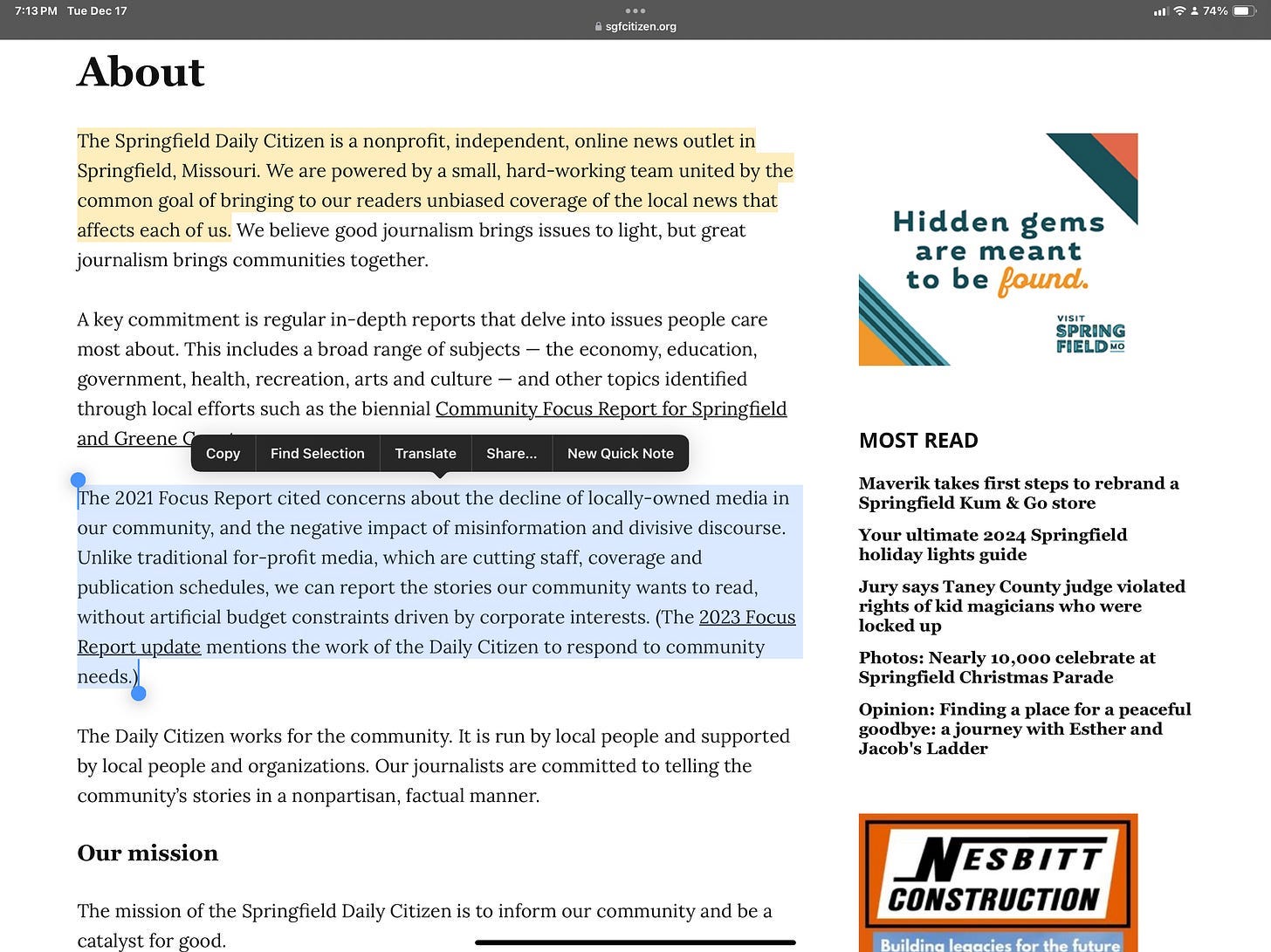

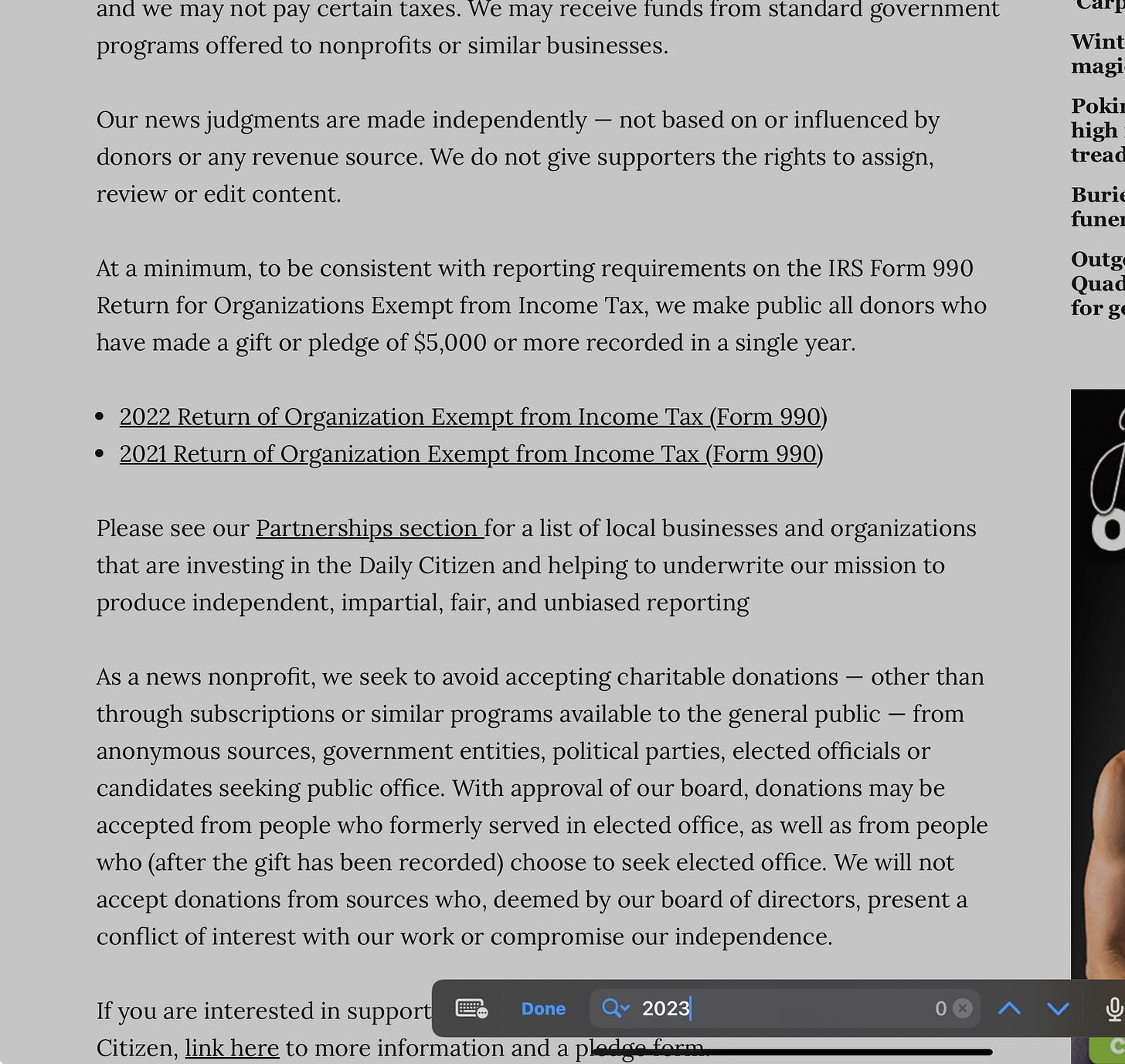
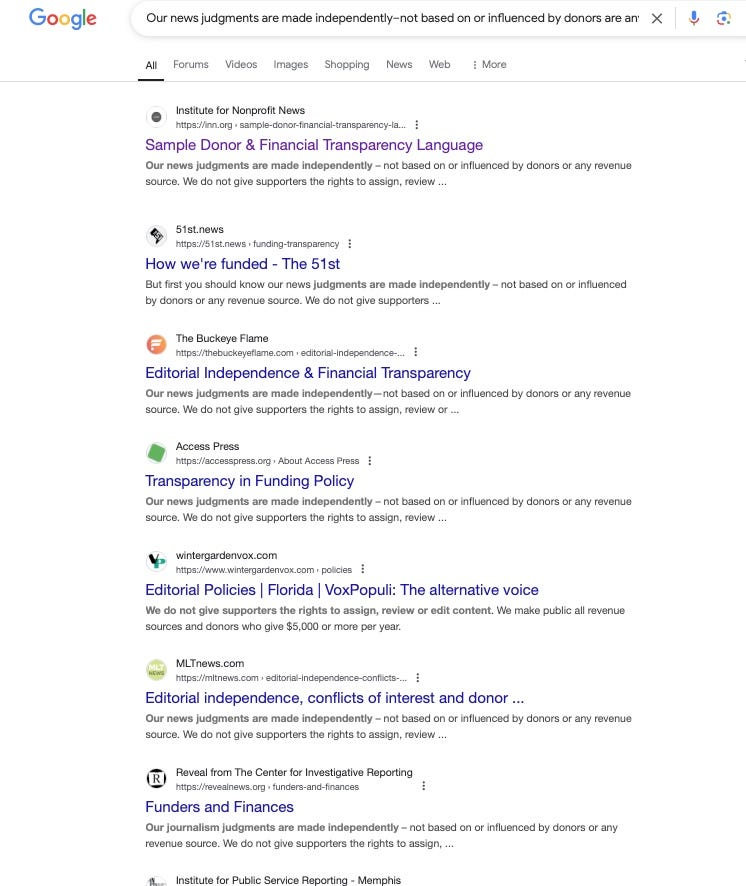





A must read. We’ve all been had, folks.